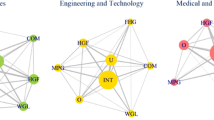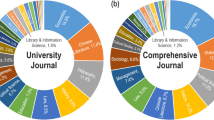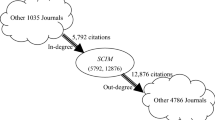Abstract
This study aims to explore the effects of both journal self citations and mutual citations within a group of journals on the increase in the impact factors (IFs) for social sciences journals published in Eastern Europe. We found that the practice of mutual citations is prevalent among the new journals, a trend that raises questions about possible manipulation of the IF and potential isolation of the recent journals from the international network of scholarly communication.





Similar content being viewed by others
References
Adams, J. D., Clemmons, J. R., & Stephan, P. E. (2004). Standing on academic shoulders: Measuring scientific influence in universities. NBER Working Paper No. 10875. Cambridge, MA: National Bureau of Economic Research.
Anseel, F., Duyck, W., de Baene, W., & Brysbaert, M. (2004). Journal impact factors and self-citations: Implications for psychology journals. American Psychologist, 59(1), 49–51.
Asknes, D. W. (2006). Citation rates and perceptions of scientific contribution. Journal of the American Society for Information Science and Technology, 57(2), 169–185.
Bergstrom, C. T., West, J. D., & Wiseman, M. A. (2008). The Eigenfactor™ metrics. Journal of Neuroscience, 28(45), 11433–11434.
Demaria, A. N. (2003). A report card for journals. Journal of the American College of Cardiology, 42(5), 952–953.
Fassoulaki, A., Paraskeva, A., Papilas, K., & Karabins, G. (2000). Self-citations in six anesthesia journals and their significance in determining the impact factor. British Journal of Anesthesia, 84(2), 266–269.
Foo, J. Y. A. (2009). A study on journal self-citations and intra-citing within the subject category of multidisciplinary sciences. Science and Engineering Ethics, 15, 491–501.
Frandsen, T. F. (2007). Journal self-citations—Analyzing the JIF mechanism. Journal of Informetrics, 1(1), 47–58.
Garfield, E., & Welljams-Dorof, A. (1992). Citation data: their use as quantitative indicators for science and technology evaluation and policy-making. Science and Public Policy, 19(5), 321–327.
Hendrix, D. (2009). Institutional self-citation rates: A three year study of universities in the United States. Scientometrics, 81(2), 321–331.
Krauss, J. (2007). Journal self-citation rates in ecological sciences. Scientometrics, 73(1), 79–89.
Maczelka, H., & Zsindely, S. (1992). All well if starts well? Citation infancy of recently launched chemistry journals. Scientometrics, 25(2), 367–372.
Pichappan, P. (1994). A dual refinement of journal self-citation measures. Scientometrics, 33(1), 13–21.
Rousseau, R. (1999). Temporal differences in self-citation rates of scientific journals. Scientometrics, 44(3), 521–531.
Tsay, M. Y. (2006). Journal self-citation study for semi-conductor literature. Synchronous and diachronous approach. Information Processing and Management, 42(6), 1567–1577.
van Nierop, E. (2009). Why do statistics journals have low impact factors? Statistica Neerlandica, 63(1), 52–62.
Van Raan, A. F. J. (2008). Bibliometric statistical properties of the top 100 largest European research universities: Prevalent scaling rules in the science system. Journal of the American Society for Information Science and Technology, 59(3), 461–475.
Yu, G., & Wang, L. (2007). The self-cited rate of scientific journals and the manipulation of their impact factors. Scientometrics, 73, 321–330.
Zhang, L., Glanzel, W., & Liang, L. (2009). Tracing the role of individual journals in a cross-citation network based on different indicators. Scientometrics, 81(3), 821–838.
Author information
Authors and Affiliations
Corresponding author
Rights and permissions
About this article
Cite this article
Teodorescu, D., Andrei, T. An examination of “citation circles” for social sciences journals in Eastern European countries. Scientometrics 99, 209–231 (2014). https://doi.org/10.1007/s11192-013-1210-6
Received:
Published:
Issue Date:
DOI: https://doi.org/10.1007/s11192-013-1210-6




